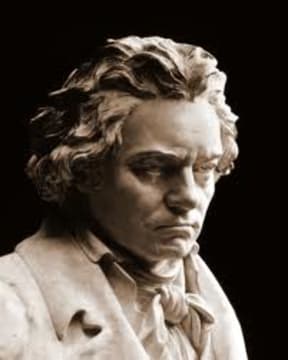Some believe that they were conceived as a set with an overarching grand schema, but Thomas Goss points out the often more expedient external factors that influenced Beethoven in composing his nine symphonies.

Beethoven Photo: Commons
Beethoven’s nine symphonies are iconic and pivotal to Western culture. Superbly crafted and intellectually soaring, they altered the whole definition of the word 'symphony'. Previously, a symphony was mainly considered an instrumental exercise for the taste of the public or the private patron. Admittedly, Haydn and Mozart turned the form toward a more personal expression. But after Beethoven’s symphonies became established as a single body of work, a symphony had to serve as creative declaration. The composer bore the responsibility of summing up not only his own bold, high-flown inspiration, but also the spirit of his generation.
The most potent indication of this was in the sudden reduction of symphonic abundance. The quantity per composer dropped immediately. From now on, a symphony required years of careful planning, not a few weeks as in the case of classical-era composers. Brahms, Schumann, and Mendelssohn each composed only four, Tchaikovsky six, and Sibelius seven. What’s more, Beethoven’s symphonies became the foundational repertoire for the establishment of civic orchestras across Europe and America. They were cornerstones to the public conception of a shared elite culture, the apotheosis of human achievement according to many musicians and philosophers.
The act of collecting these works together as one combined statement elevated their context. Rivers of ink were spilled about their unity of purpose and grand scheme, as if they had been composed all along as a set of works. It was observed quite often that the odd-numbered works were immortal pronouncements - especially the Third, the Fifth, and the Ninth. The even-numbered works were gentler bridges over the chasms between these epic summits.
This ultimately fed back upon the posthumous cult of Beethoven; a cultural mirror through which musicians compared their own challenges and intellectual growth. Even a usually more sober music critic such as Debussy might write about the 'mystic significance' of the number nine to Beethoven. A type of musical numerology evolved, in which numbers meant something. A composer knew well that his third symphony would be compared to the Eroica, and his fifth to Beethoven’s Fifth. If he was lucky enough and productive enough to reach a ninth Symphony, as with Dvořák, Mahler, Bruckner, and Shostakovich, the public expectation would lie heavily upon him to live up to the Choral Symphony.
All this might have amused Beethoven had he but known. To him, this 'unified vision' was a collection of highly various works; some carefully planned, some growing out of others, and one or two even occurring by purest chance. Rather than a steady stream of calculated inspiration according to a grand scheme, the symphonies seem to have been created in bursts. An initial period of creation covered the first few, from the attention-getting First to a culmination of creative power in the Third. The Fourth, Fifth, and Sixth came a few years later in a combined crush of inspiration and hard work. After some years, the Seventh and Eighth stepped on each other’s toes. Then a decade-long silence was broken by the final Ninth symphony, a monumental work that was anything but the composer’s final thoughts.

